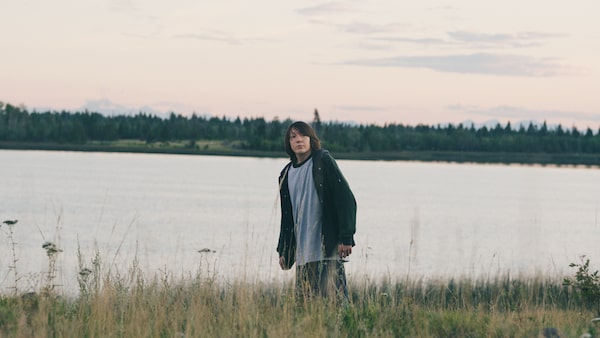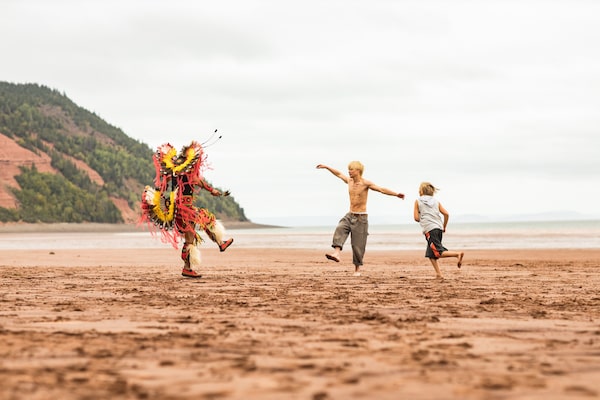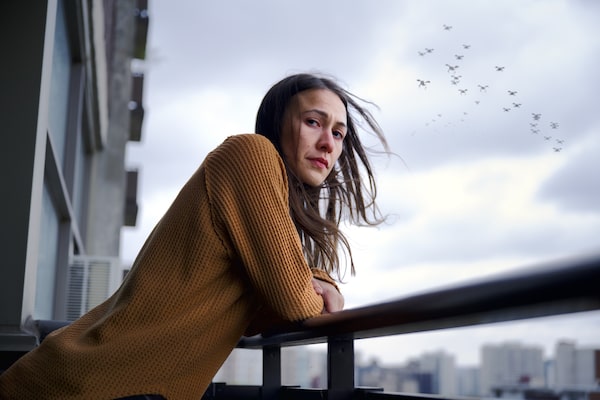
Portraits From a Fire. A teenager shows his DIY films on his reserve, despite a lack of interest.Handout
Growing up on the Tl’etinqox reserve in British Columbia, Trevor Mack could tell when something serious was going on. The adults would switch from English to Tsilhqot’in – so the kids wouldn’t understand.
“We only associated the language with bad things, because that’s the only time when our parents would speak it,” says Mack, whose debut feature Portraits from a Fire was filmed partly in Tsilhqot’in – a language Mack is now learning to speak. The film has its world premiere at this year’s Vancouver International Film Festival.
Filming on-location on the reserve – one of six Tsilhqot’in communities located in the B.C. Interior – Mack would tell the performers (many of whom were not professional actors, but people from the community) what he wanted them to say. And he had “beautiful full trust” that they were doing that. This was a critical element of the project that he knows will resonate.
Documentary Returning Home intertwines narratives concerning residential school survivors, including Orange Shirt Day founder Phyllis Jack-Webstad.Handout
“To have our youth hear the language in the movie, just to have our elders speak it, it’s those vibrations that we’re creating. The crew are hearing this language,” Mack says. “Whatever effect that’s having, who knows what that’s going to be?”
We often hear how important it is for audiences to be able to see themselves onscreen. But hearing the language of your people can also be transcendent. There is an added weight to this for Indigenous people, whose languages suffered catastrophic losses as a result of racist colonial policies. Many children who were forced to go to residential school arrived knowing no English, but were forbidden from speaking their own language. Some were afraid to, even long after they left school.
Indigenous filmmakers, many of whom barely speak these languages themselves – the result of what happened to their parents, grandparents and other relations – might not know the words, but they understand their power. And they are using it.
“There’s an element of representation of seeing the language mirrored back to you,” says Sean Stiller, a 37-year-old filmmaker who is Secwépemc on his mother’s side and settler on his father’s. “I suppose the word that comes there is ‘pride.’”
Stiller’s debut feature documentary, Returning Home, tells the story of Phyllis Jack-Webstad. She was 6 when she was sent to St. Joseph’s Mission Residential School. Her grandmother wanted to give her something special to wear. Phyllis chose a shiny orange shirt, but when she got to the school, she explains in the film, she was stripped and the shirt was taken away. “So I wear it today as a symbol of the healing that’s taking place,” says the founder of the Orange Shirt Society, in the film.
“I lost everything at that school: my identity, my culture, my language,” another survivor, Esk’etemc First Nation Chief Fred Robbins, tells the Truth and Reconciliation Commission. “All of this was taken away when I was six years old.”
The documentary – the first feature production by Canadian Geographic – interweaves two Canadian catastrophes: the residential schools tragedy and the depletion of salmon stocks.
The film opens with a prayer of thanks in Secwepemctsin – a language which is in “extinction territory,” as Stiller describes it. It is one of several Indigenous languages – others include Cree, Mi’kmaq and Tsilhqot’in – that audiences will be able to hear at this year’s Vancouver International Film Festival.
“I think it’s one amazing part that film can play in supporting the strengthening and, in some cases, the revival of Indigenous languages. That we can provide a story in context, in language, and how that language relates to the story,” VIFF executive director Kyle Fostner says. “It’s part of an overall surge in just incredible Indigenous filmmaking.”

In Mi’kmaw filmmaker Bretten Hannam’s Wildhood, Link (Phillip Lewitski) and his half-brother Travis (Avery Winters-Anthony) run away to escape their abusive father and look for Link’s mother, who is Mi’kmaw.Riley Smith/The Canadian Press
Cree-Métis filmmaker Danis Goulet’s residential-school sci-fi parable Night Raiders arrives in Vancouver after Goulet received the Emerging Talent Award at the Toronto International Film Festival. In the film, set in the near future, elders plot strategy in Cree. They are trying to defend their children and their land from terrifying drone-employing colonizers who vow “one country, one language, one flag.”
In Mi’kmaw filmmaker Bretten Hannam’s Wildhood, Link (Phillip Lewitski) and his half-brother Travis (Avery Winters-Anthony) run away to escape their abusive father and look for Link’s mother, who is Mi’kmaw. On the way, they meet Pasmay (Joshua Odjick), a powwow dancer who is very connected to the culture. In Link’s journey, healing comes from being true to his two-spirit self and his culture. He learns some Mi’kmaq words from Pasmay: “mother,” “son.”
Bootlegger, which has its world premiere at VIFF, was filmed in French and Anishinaabemowin by first-time feature director Caroline Monnet. In the film, Mani (Kawennáhere Devery Jacobs) returns to the community where she grew up, which is debating whether to remain alcohol-free. Mani, there to complete her thesis, faces obstacles that include conflict with the local bootlegger, a white woman.
Ottawa-born Monnet, who is Algonquin and French, does not speak Anishinaabemowin. “It’s my grandfather’s first language, but because of obviously everything that happened, he never taught his kids. My mother doesn’t speak it. So it’s my generation’s responsibility to relearn it and reappropriate it,” says Monnet, 36, from Montreal, where she is now based.
Like Mack, she was supported by community elders who played the roles. She also hired translators and a language coach.
“We have the tools now to be able to make and create films and become the storytellers that we are,” she says. “And with that comes the responsibility of showing our communities and telling our stories. And often that comes with the language, because it’s such an integral and important part of our cultures. And we know that in order to keep them alive, we need to continue speaking them and showcasing them and be proud of them.”

Elle-Maija Tailfeathers stars as a Cree mother trying to reunite with her daughter in Danis Goulet's thriller Night Raiders.TIFF via The Canadian Press
In Vancouver, Mack, 29, began envisioning Portraits from a Fire in 2016, in the aftermath of a violent downtown assault that left him on bedrest with his jaw wired shut. Fast forward to 2019, about three months before production was scheduled to begin, and Mack began to have serious doubts. He felt the story needed to be radically reworked.
“The images that we should be portraying back to our people should be positive imagery of our Native men, positive imagery of our Native women, something to inspire the youth,” says Mack, who scrapped the original version of the script. “We were rejecting a portrayal of our people that focused on what needs to be healed rather than the healing itself.”
The film stars the amazing young Tsilhqot’in actor William Magnus Lulua as Tyler, a teenage filmmaker whose mother died when he was a baby and whose father has checked out emotionally. Tyler shows his homemade movies to tiny audiences on his reserve. At a crucial part of the film, Tyler speaks in Tsilhqot’in – the young actor’s idea.
Ahead of its VIFF world premiere, Portraits was shown to the community on the reserve where it was shot.
“We actually screened it in the old overgrown arena that’s just the exact same place where Tyler screens his films in the movie. So it was this super meta experience that couldn’t have went any better, where we were surrounded by the exact same environment that he was surrounded by in the movie,” says Mack, who is now learning Tsilhqot’in.
At the end of the film, there is a scene that came directly from something one of the elders who appears in the film said when Mack asked him to be in the film. The scene received a wild reception at that screening.
“That was the biggest laughter eruption. And it was something that came out of the magic of collaboration with the community,” Mack says. “To hear the laughter of my people was medicine.”
In Bootlegger, Mani (Kawennáhere Devery Jacobs) leaves Montreal for the Algonquin community where she spent her formative years.Handout
VIFF runs Oct. 1-11.
Plan your screen time with the weekly What to Watch newsletter. Sign up today.
 Marsha Lederman
Marsha Lederman